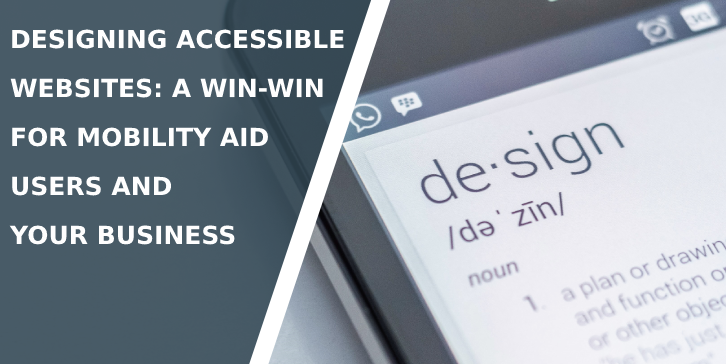Introduction
In today’s digital age, where the internet plays a vital role in our daily lives, it’s essential to recognise the importance of creating accessible websites that cater to all users, including those who rely on mobility aids.
The term “mobility aid users” encompasses individuals with physical disabilities, such as wheelchair users, crutch or cane users, and people with limited mobility. By optimising websites to be more inclusive and accommodating to this demographic, businesses can reap numerous benefits, including improved user engagement, increased customer satisfaction, and, ultimately, higher conversions.
Understanding Accessibility and Its Impact
Accessibility is the practice of designing websites, products, and services in a way that allows people with disabilities to access and use them easily. Web accessibility is particularly crucial as it ensures that everyone, regardless of their abilities, can interact with the online world without barriers. When we talk about mobility aid users, the focus is on creating an environment where they can navigate and interact with websites seamlessly.
Incorporating web design that includes closed captions and subtitles is crucial when designing accessible websites for mobility aid users and your business. This inclusive approach ensures that all users, regardless of their abilities, can access and engage with your website content, ultimately broadening your audience reach and promoting inclusivity.
The Importance of Designing for Mobility Aid Users
- Inclusive User Experience: By implementing accessible design principles, businesses can create an inclusive user experience that welcomes a broader audience. By removing obstacles for mobility aid users, your website becomes more user-friendly for everyone.
- Legal and Ethical Obligations: Several countries have laws and regulations mandating website accessibility, such as the Americans with Disabilities Act (ADA) in the United States and the Web Accessibility Directive in the European Union. Complying with these laws not only prevents potential legal issues but also demonstrates your commitment to inclusivity and social responsibility.
- Tapping into a Lucrative Market: People with disabilities make up a significant consumer market with substantial purchasing power. By catering to their needs, businesses can tap into this underserved market and gain a competitive advantage.
Elements of an Accessible Website
- Keyboard Navigation: Ensure that all website features and functions can be accessed and operated using only a keyboard. This is particularly important for mobility aid users who may have difficulty using a mouse.
- Alt Text for Images: Use descriptive alt text for images, allowing screen readers to convey the content to visually impaired users.
- Proper Heading Structure: Implement a clear and hierarchical heading structure to facilitate navigation for screen reader users.
- Color Contrast: Ensure sufficient colour contrast between text and background to assist users with visual impairments.
- Captioned Multimedia: Provide captions and transcripts for videos and audio content to accommodate hearing-impaired users.
- Responsive Design: Create a responsive website that adapts to various screen sizes and devices, accommodating users who may use different assistive technologies.
Benefits of Website Accessibility for Businesses
- Improved User Engagement: An accessible website enhances user engagement by creating a positive user experience for all visitors, regardless of their abilities. Users are more likely to spend time on a site that is easy to navigate and understand.
- Increased Customer Satisfaction: By prioritising the needs of mobility aid users, businesses demonstrate their commitment to customer satisfaction and inclusivity. Satisfied customers are more likely to return and recommend the website to others.
- Positive Brand Image: Embracing accessibility fosters a positive brand image, portraying the business as socially responsible and compassionate, which resonates with a broader audience.
- Enhanced SEO: Many accessibility practices, such as proper heading structure and descriptive image alt text, also benefit search engine optimisation (SEO), improving the website’s visibility in search results.
- Higher Conversions: A more inclusive website leads to higher conversions as it encourages users to complete desired actions, such as making a purchase, signing up for newsletters, or requesting information.
Case Studies and Success Stories
Highlighting case studies and success stories of businesses that have implemented accessible design can be compelling. Showcase how these businesses improved their user experience, garnered positive feedback, and witnessed tangible improvements in their bottom line.
Conclusion
Designing accessible websites is not just a moral obligation but also a strategic business decision. By catering to the needs of mobility aid users, businesses can create a positive user experience for a diverse audience, leading to increased customer satisfaction, improved engagement, and, ultimately, higher conversions.
Embracing accessibility fosters a positive brand image, opens up new markets, and demonstrates a commitment to inclusivity and social responsibility. As technology continues to evolve, it is crucial for businesses to embrace accessibility, ensuring that the digital world is accessible to everyone.
Ryan is a professional copywriter from Ryan’s Copywriting. He has a passion for writing and sharing information.

